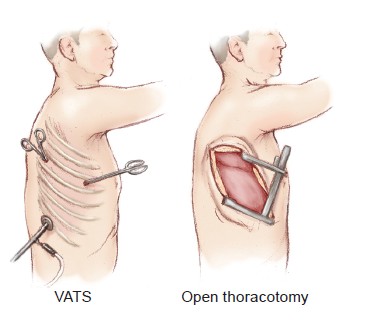Minimally Invasive Pulmonary Resection
 In the past, lung surgery required a major open procedure, known as a
thoracotomy. In order to gain access to the lungs, this approach involves
making a large incision and spreading the ribs apart with retractors. With
new technological developments, it is now possible to perform lung surgery via
a less invasive approach, known as “Minimally Invasive Pulmonary Resection”.
In the past, lung surgery required a major open procedure, known as a
thoracotomy. In order to gain access to the lungs, this approach involves
making a large incision and spreading the ribs apart with retractors. With
new technological developments, it is now possible to perform lung surgery via
a less invasive approach, known as “Minimally Invasive Pulmonary Resection”.
Definition
There are two forms of minimally invasive or “key-hole” thoracic surgery: VATS (Video-Assisted Thoracoscopic Surgery) and Robotic Surgery. Both of these techniques involve insertion of instruments through a number of small incisions in the chest wall. One of the instruments is a small camera, or thoracoscope, which projects to a monitor at the bedside. This allows the surgeon to see inside the chest cavity in a magnified fashion during the operation.
Procedure
The surgery is performed in an operating theatre and requires a general anaesthetic. The larger incision is usually 4-6 cm long. Under the guidance of the camera or “thoracoscope”, portions of the lung are removed using instruments inserted through the incisions or “ports”. A chest drain is inserted at the end of the operation, which is usually removed a day or two later.
Uses
VATS can be performed for a number of different types of procedures including:
• Lobectomy (removing a lobe of the lung)
• Wedge resection (removing a smaller portion of lung)
• Lung biopsy (removing a piece of lung tissue to make a diagnosis)
• Other: draining pleural effusions, treating spontaneous pneumothorax, lymph node dissection, surgery on other structures including the mediastinum and oesophagus
Benefits
There are a number of benefits of minimally invasive pulmonary resection compared to open thoracotomy. These include:
• Smaller incisions, hence better cosmesis
• Reduced risk of bleeding
• Reduced post-operative pain
• Shorter hospital stay, usually 3-4 days
• More rapid return to full activity
Risks
There are risks associated with every surgical procedure. Potential complications of minimally invasive approach include:
• Air leak requiring the chest tube to remain in for longer than planned
• Bleeding requiring conversion to open approach
• Infection such as pneumonia
Suitability
While most patients can be considered for VATS or Robotic Surgery, some cases may not be appropriate and will require a traditional thoracotomy. These include previous lung surgery and larger or more centrally located tumours. The thoracic surgeon will discuss the risks and benefits of different management options and will assist the decision for the most appropriate management for each patient. Currently, the long-term outcomes of VATS lobectomy are at least equivalent to open approach.
For more information
Visit the following websites:
http://www.health.harvard.edu/diagnostic-tests/videoassisted-
thoracic-surgery.htm
http://thoracicsurgery.stanford.edu/patient_care/
http://www.sts.org/sections/patientinformation/
lungthoracicsurgery/
Section Writer: Rebecca Harris
Illustration Editor: Beth Croce
Section Editor: Tristan D. Yan
For specific information concerning your medical condition, ACS suggests that you consult your physician. This page may be photocopied noncommercially by physicians to share with patients.





